
Crambe is a genus of annual and perennial flowering plants in the family Brassicaceae, native to a variety of habitats in Europe, Turkey, southwest and central Asia and eastern Africa. They carry dense racemes of tiny white or yellow flowers on stems above the basal leaves. Crambe hispanica subsp. abyssinica, formerly known as Crambe abyssinica, is grown for the oil from the seeds that has characteristics similar to whale oil.
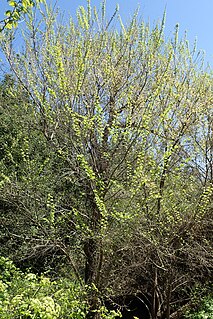
Ulmus minorsubsp.canescens is a small deciduous tree occasionally known by the common names grey elm, grey-leafed elm, and hoary elm. Its natural range extends through the lands of the central and eastern Mediterranean, from southern Italy, the islands of Sicily, Malta, Crete, Rhodes and Cyprus, to Turkey, and as far south as Israel, where it is now considered rare and endangered in the wild. The tree is typically found amidst the comparatively humid coastal woodlands and scrublands.

Phyla nodiflora, the frog fruit, sawtooth fogfruit, or turkey tangle, is an ornamental plant in the family Verbenaceae, and is native to the area between the north of South America to the southern United States. It can be found in tropical areas around the globe, a naturalized species in many places. This plant is cited in Flora Brasiliensis by Carl Friedrich Philipp von Martius.
Goldman's diminutive woodrat is a species of rodent in the family Cricetidae. It is found only in Mexico.
Nelsonia is a genus of rodent in the family Cricetidae, found in Mexico. It contains the following species:
The diminutive woodrat is a species of rodent in the family Cricetidae. It is endemic to Mexico.
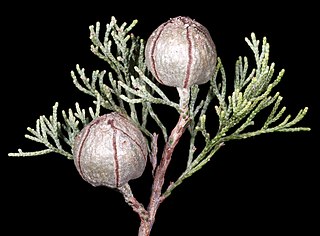
Callitris canescens is a species of conifer in the family Cupressaceae. It is found only in Australia.

The grayish mouse opossum is a species of opossum endemic to Mexico. It is the sole species in the genus Tlacuatzin.

Gymnostachyum is an Asian genus of plants in the family Acanthaceae.

Calamagrostis canescens, known as purple small-reed, is a species of grass in the family Poaceae, native to Europe and western Siberia.
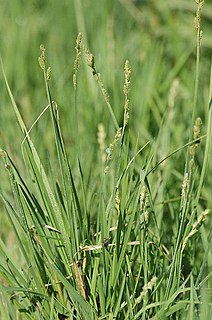
Carex canescens L. is a perennial species of plants in the family Cyperaceae growing in damp forests and wetlands. It is widespread across much of Europe, Asia, Australia, New Guinea, North America, and southern South America.

Solanum lanceolatum, with the common names orangeberry nightshade and lanceleaf nightshade, is a species of nightshade. It is native to regions of South America, including the Cerrado ecoregion of the Tropical and subtropical grasslands, savannas, and shrublands biome, primarily in Brazil.
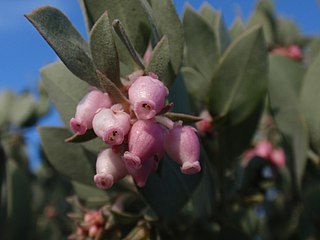
Arctostaphylos canescens, common name hoary manzanita, is a species of manzanita.

Dieteria canascens is an annual plant or short lived perennial plant in the daisy family, known by the common names hoary tansyaster and hoary-aster.
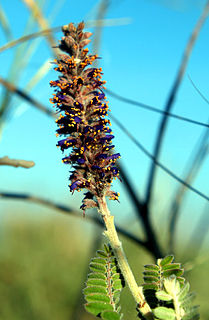
Amorpha canescens, known as leadplant, downy indigo bush, prairie shoestring, or buffalo bellows, is a small, perennial semi-shrub in the pea family (Fabaceae), native to North America. It has very small purple flowers with yellow stamens which are grouped in racemes. Depending on location, the flowers bloom from late June through mid-September. The compound leaves of this plant appear leaden due to their dense hairiness. The roots can grow up to 5 m (16 ft) deep and can spread up to 1 metre radially. This plant can be found growing in well-drained soils of prairies, bluffs, and open woodlands.

Salvia canescens, the hoary sage, is a herbaceous perennial that is endemic to the Caucasus mountains. The specific epithet, canescens, refers to the off-white hairs covering the leaves.

Petrophile canescens, commonly known as conesticks, is a species of flowering plant in the family Proteaceae and is endemic to eastern Australia. It is an erect shrub with pinnately-divided leaves and oval heads of hairy, white to pale cream-coloured flowers.
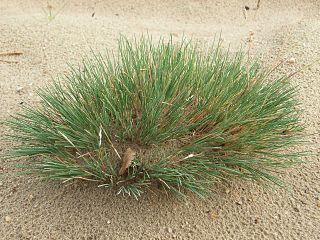
Corynephorus canescens, common name grey hair-grass or gray clubawn grass, is a species of plants in the grass family, native to Europe, the Middle East, and North Africa but widely naturalized in North America. In the United Kingdom it is rare. It can be found at sites such as Wangford Warren and Carr, a Site of Special Scientific Interest in the Breckland area of Suffolk.
Ryania is a genus of plants in the family Salicaceae; it was previously listed in the now defunct family Flacourtiaceae.

Nelsonia is a genus of plants in the family Acanthaceae. They can be found in tropical: Africa, Latin America, south-east Asia and Australia.



















